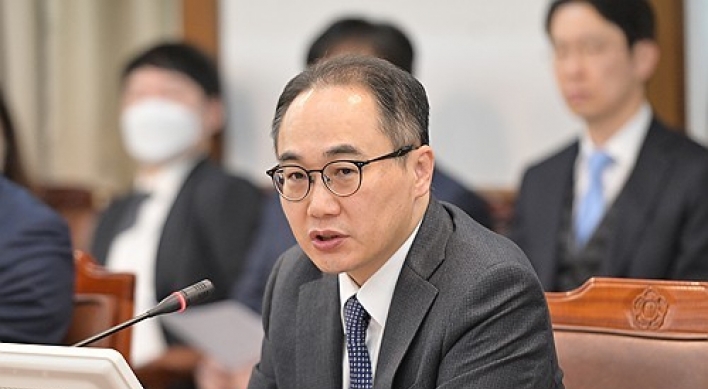Life is full of hope and dreams for Lee Seo-hyun, a 9-year-old child attending a primary school in Namyangju, Gyeonggi Province. She wants to be a painter, teacher, owner of a big supermarket, florist, designer, scientist, and more.
Every day, she wakes up and goes to school by 8 a.m. When school finishes at around 2 p.m., she briefly plays with her friends in the playground until she goes to her private lessons for piano, computer classes and English.
“When the lessons are over at around 4 p.m. I am free. I invite friends to my parents’ stationery shop and play. I really like spending time with my friends,” Lee told The Korea Herald in a cheerful, high-pitched tone.
As Children’s Day -- May 5 -- is just around the corner, Lee cannot wait to go on a picnic with her friends and open a gift from her parents.
“I would love to receive a doll from my parents, but I don’t know what they will get me,” she said. “I want to own a big supermarket, then I can have anything I want!”
Statistics suggest that kids in Korea today enjoy a higher quality of life than in any other generation, but they are the least happy among children in the developed world due largely to academic stress and fierce competition at schools.
Lee said she also started to feel pressured about studying and taking after-school classes. “When I have fun with my friends, sometimes I don’t want to study or go to after-school classes.”

According to 2015 data compiled by the Organization for Economic Cooperation and Development, child poverty in Korea has decreased since 2007, with only 7.7 percent of children aged 18 or lower living in households with a disposable income of less than half the Korean median income.
In terms of children’s health, the rates of infant mortality and low birth weight are below the OECD average. Korean children’s academic achievement is notable, with students aged 15 to 19 ranking second in the OECD in reading and first in problem-solving using computers.
But Korean children’s happiness and satisfaction with their lives were among the bottom, scoring 90.4 compared to the OECD average of 100 according to Pang Chong-hwan Foundation last year. The survey was conducted on 7,536 students aged 19 and younger. The highest score was 119.4 by Spain. Among primary school kids, 14.3 percent felt suicidal, followed by middle school students at 19.5 percent and high school students at 24 percent.
A 25-year-old primary school teacher, who wanted to be identified only by her surname Jang, said that children are very “busy” these days, enjoying less time to play and explore.
“Their life is different from mine as a child. They are very sensitive about exams and they are used to competing against each other,” said Jang, who has taught sixth-graders for three years. “With parents overly passionate about their children’s education, most of the kids take extra private lessons, mostly to improve math and English … and at least two or three cram schools until the night.”
“On Children’s Day, many of my kids said they would go to private institutes for extra study.”
According to Statistics Korea, 68.8 percent of the children took private education in 2015, spending 5.7 hours on average per week. Just over 17 percent said that their free time did not last an hour.
A lack of balance between work and life for Korean parents is also blamed for more children going to cram schools -- an option for parents to keep them safe and less lonely. Korean parents work for an average of 2,124 hours per year, the second highest among the OECD countries. The latest data by the OECD shows that Korean children spent only 48 minutes daily with their parents last year.
A growing use of smart devices has also changed the children’s lives, especially in how they form relationships and learn social skills, Jang pointed out.
“As many kids go to after-school classes until late at night, social media such as KakaoTalk or Skype has become a key tool for them to interact with each other,” she said. “Communication, getting to know each other and bullying all take place online.”
“I hope that my students grow up as warm-hearted people who are willing to help each other rather than compete against one another.”
Calls are also rising for society to better protect the rights of children, particularly in the time of increasing child abuse cases.
According to the Health Ministry, the amount of child abuses including negligence has steadily increased from 10,943 in 2012 and 13,076 in 2013 to 17,991 in 2014.
“Parents and children seem to talk less these days in nuclear families. They interact less with each other face-to-face due to wide use of smartphones,” said Lee Bae-young, a professor at Sungsan Hyo University. “The lack of interaction leads to mental health problems such as depression, but they don’t know where to seek help.”
Yet, as South Korean women have 1.24 children in their lifetime, less than any other OECD member countries, many loving parents tend to spend more money than ever on their children. The trend created a new term “gold kids” referring to only child being brought up like royalty in their families.
Businesses are busy rolling out products and services for children including furniture and cars with more safety measures, luxurious toys and fashion items and IT devices which can locate their kids. In 2015, the country saw a 12 percent increase in spending from a year earlier, but spending on children’s products soared by 81.3 percent.
By Ock Hyun-ju (laeticia.ock@heraldcorp.com)
Every day, she wakes up and goes to school by 8 a.m. When school finishes at around 2 p.m., she briefly plays with her friends in the playground until she goes to her private lessons for piano, computer classes and English.
“When the lessons are over at around 4 p.m. I am free. I invite friends to my parents’ stationery shop and play. I really like spending time with my friends,” Lee told The Korea Herald in a cheerful, high-pitched tone.
As Children’s Day -- May 5 -- is just around the corner, Lee cannot wait to go on a picnic with her friends and open a gift from her parents.
“I would love to receive a doll from my parents, but I don’t know what they will get me,” she said. “I want to own a big supermarket, then I can have anything I want!”
Statistics suggest that kids in Korea today enjoy a higher quality of life than in any other generation, but they are the least happy among children in the developed world due largely to academic stress and fierce competition at schools.
Lee said she also started to feel pressured about studying and taking after-school classes. “When I have fun with my friends, sometimes I don’t want to study or go to after-school classes.”

According to 2015 data compiled by the Organization for Economic Cooperation and Development, child poverty in Korea has decreased since 2007, with only 7.7 percent of children aged 18 or lower living in households with a disposable income of less than half the Korean median income.
In terms of children’s health, the rates of infant mortality and low birth weight are below the OECD average. Korean children’s academic achievement is notable, with students aged 15 to 19 ranking second in the OECD in reading and first in problem-solving using computers.
But Korean children’s happiness and satisfaction with their lives were among the bottom, scoring 90.4 compared to the OECD average of 100 according to Pang Chong-hwan Foundation last year. The survey was conducted on 7,536 students aged 19 and younger. The highest score was 119.4 by Spain. Among primary school kids, 14.3 percent felt suicidal, followed by middle school students at 19.5 percent and high school students at 24 percent.
A 25-year-old primary school teacher, who wanted to be identified only by her surname Jang, said that children are very “busy” these days, enjoying less time to play and explore.
“Their life is different from mine as a child. They are very sensitive about exams and they are used to competing against each other,” said Jang, who has taught sixth-graders for three years. “With parents overly passionate about their children’s education, most of the kids take extra private lessons, mostly to improve math and English … and at least two or three cram schools until the night.”
“On Children’s Day, many of my kids said they would go to private institutes for extra study.”
According to Statistics Korea, 68.8 percent of the children took private education in 2015, spending 5.7 hours on average per week. Just over 17 percent said that their free time did not last an hour.
A lack of balance between work and life for Korean parents is also blamed for more children going to cram schools -- an option for parents to keep them safe and less lonely. Korean parents work for an average of 2,124 hours per year, the second highest among the OECD countries. The latest data by the OECD shows that Korean children spent only 48 minutes daily with their parents last year.
A growing use of smart devices has also changed the children’s lives, especially in how they form relationships and learn social skills, Jang pointed out.
“As many kids go to after-school classes until late at night, social media such as KakaoTalk or Skype has become a key tool for them to interact with each other,” she said. “Communication, getting to know each other and bullying all take place online.”
“I hope that my students grow up as warm-hearted people who are willing to help each other rather than compete against one another.”
Calls are also rising for society to better protect the rights of children, particularly in the time of increasing child abuse cases.
According to the Health Ministry, the amount of child abuses including negligence has steadily increased from 10,943 in 2012 and 13,076 in 2013 to 17,991 in 2014.
“Parents and children seem to talk less these days in nuclear families. They interact less with each other face-to-face due to wide use of smartphones,” said Lee Bae-young, a professor at Sungsan Hyo University. “The lack of interaction leads to mental health problems such as depression, but they don’t know where to seek help.”
Yet, as South Korean women have 1.24 children in their lifetime, less than any other OECD member countries, many loving parents tend to spend more money than ever on their children. The trend created a new term “gold kids” referring to only child being brought up like royalty in their families.
Businesses are busy rolling out products and services for children including furniture and cars with more safety measures, luxurious toys and fashion items and IT devices which can locate their kids. In 2015, the country saw a 12 percent increase in spending from a year earlier, but spending on children’s products soared by 81.3 percent.
By Ock Hyun-ju (laeticia.ock@heraldcorp.com)
-
Articles by Korea Herald




![[Graphic News] Number of coffee franchises in S. Korea rises 13%](http://res.heraldm.com/phpwas/restmb_idxmake.php?idx=644&simg=/content/image/2024/05/02/20240502050817_0.gif&u=)



![[Robert J. Fouser] AI changes rationale for learning languages](http://res.heraldm.com/phpwas/restmb_idxmake.php?idx=644&simg=/content/image/2024/05/02/20240502050811_0.jpg&u=)









![[Eye Interview] 'If you live to 100, you might as well be happy,' says 88-year-old bestselling essayist](http://res.heraldm.com/phpwas/restmb_idxmake.php?idx=652&simg=/content/image/2024/05/03/20240503050674_0.jpg&u=)
